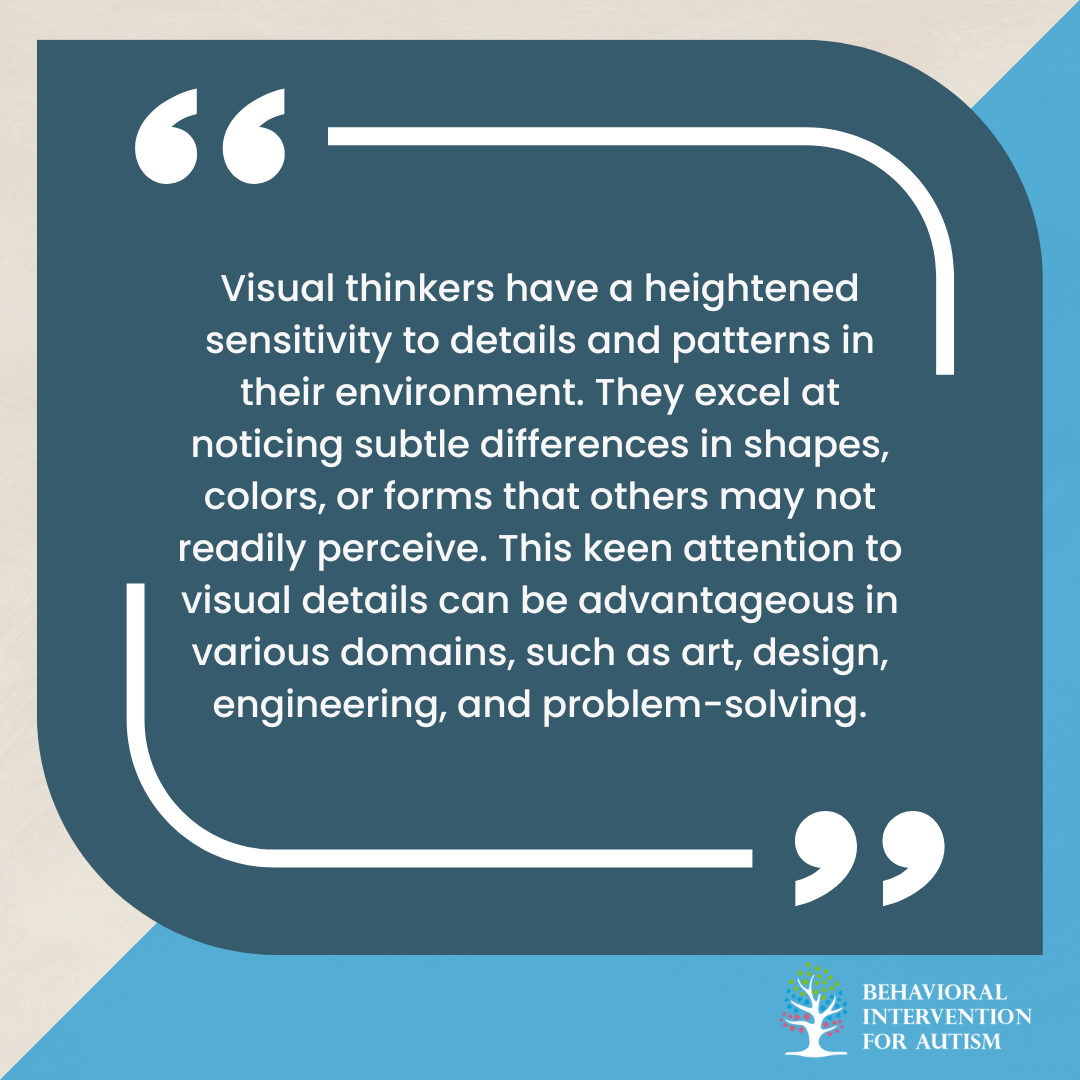
Table of Contents
Autistic people often exhibit a unique thinking style that is characterized by a strong inclination toward visual processing. This visual thinking style involves using visual images to solve problems, create new ideas, and understand complex concepts.
What is Visual Thinking
Visual thinking, also referred to as visual-spatial ability, allows individuals to think in pictures and process information visually. This thinking style goes beyond just images and encompasses forms, shapes, lines, colors, scale, proximity, and cognitive dimensions.
Autistic individuals, although not exclusive to all, commonly exhibit visual thinking tendencies.
The idea that autistic people are highly visual thinkers gained prominence through the writings of Temple Grandin, a leading engineer and self-advocate diagnosed with autism. Grandin eloquently described her thinking process as “thinking in pictures” rather than relying on words.
While visual thinking can present challenges in certain areas, it also provides autistic individuals with unique strengths in visual processing.
Visual Learning in Autism
Understanding how individuals with autism process information is crucial for effective learning and communication strategies. Visual thinking, which is commonly observed in autistic individuals, plays a significant role in their learning process.
However, it is important to note that not all autistic individuals are exclusively visual learners.
It comes with a handful of advantages which are as follows:
- Autistic people often exhibit strong visual thinking skills, which can manifest in various ways. They excel in tasks such as puzzles, organizing objects, and remembering routes. This visual strength enables them to perceive and process information in a unique and profound manner.
- Visual tools, such as picture cards, video models, and related resources, can greatly benefit autistic individuals in understanding concepts without relying solely on verbal explanations. These visual supports provide a more accessible and comprehensible way for individuals to grasp information.
- Visual-spatial ability, also known as visual thinking, allows autistic individuals to think in pictures, absorb information visually, and enhance their understanding beyond reading or listening. They have an innate talent for noticing subtle details, patterns, and discrepancies in their surroundings.
- While visual thinking is not exclusive to all autistic individuals, it is commonly observed within the autistic population. Many autistic individuals are highly sensitive to visual stimuli and have a keen eye for details. This heightened sensitivity enables them to perceive and analyze visual information with great precision.
- Visual aids, such as icons and color labeling, can significantly impact the daily lives of autistic individuals. These tools assist with time perception, memory retention, and task completion. By utilizing visual strategies, individuals with autism can navigate their world more effectively and achieve greater independence.
At the same time, it also comes with the following limitations:
- Autistic individuals, particularly those with sensory processing profiles that are more sensitive and avoidant, may find it challenging to process spoken information. This can make verbal communication overwhelming or difficult to comprehend.
- Research has revealed that individuals with autism process visual information differently from their neurotypical counterparts. While some aspects of visual processing may be enhanced, such as visual acuity and pattern recognition, challenges may arise in higher-order processing tasks like face recognition.
- Studies have shown that autistic individuals demonstrate enhanced abilities in identifying patterns with horizontal and diagonal lines of symmetry compared to neurotypical individuals. This ability to extract global patterns from noise suggests atypical visual processing.
- Atypical visual processing in individuals with autism is believed to be related to changes in connectivity within the brain. Enhanced abilities observed in visual tasks may be attributed to alterations in the wiring of the visual cortex.
- Autistic individuals exhibit different patterns of brain activity compared to their neurotypical counterparts. They often show increased activity in the temporal and occipital regions, which are associated with visual processing, and decreased activity in the frontal cortex, which is involved in higher-order cognitive functions.
Understanding the advantages and limitations of visual learning in autism is crucial for creating effective educational strategies and providing appropriate support. By leveraging visual thinking strengths and addressing challenges, educators, caregivers, and individuals with autism can optimize learning experiences and promote successful outcomes.
Enhanced Visual Abilities in Autism
Autistic individuals often exhibit enhanced visual abilities, which play a significant role in how they perceive and interact with the world. This section explores two aspects of enhanced visual abilities in autism: perceptual processing and brain resource allocation.
Enhanced perceptual processing is a core feature of neural organization in the autistic population. Autistic individuals demonstrate a stronger engagement of the visual system across various tasks, confirming their exceptional perceptual abilities.
This heightened engagement of the visual processing brain areas allows them to excel in tasks that involve visual detection, pattern recognition, and object identification.
A meta-analysis of 26 independent brain imaging studies involving autistic and non-autistic individuals revealed that autistics exhibit more activity in regions associated with perceiving and recognizing patterns and objects. This heightened activation in the temporal and occipital regions of the brain aligns with their enhanced visuo-spatial abilities.
The enhanced perceptual processing in autism provides a physiological basis for the cognitive accounts of autistic perception, learning, memory, and reasoning. It contributes to their unique way of processing and understanding information, which differs from neurotypical individuals.
Brain Resource Allocation
The autistic brain adapts by reallocating brain areas to visual perception, indicating a general functional reorganization of the brain in favor of perceptual processes. Autistic individuals concentrate their brain resources in areas associated with visual detection and identification, which contributes to their exceptional visual abilities.
In contrast, autistic individuals show reduced activity in frontal cortex areas responsible for higher cognitive functions such as planning and controlling thoughts and actions. This altered pattern of brain resource allocation suggests a trade-off between enhanced visual abilities and challenges in certain higher-order tasks.
The stronger engagement of the visual processing brain areas and the reduced activity in certain frontal cortex areas reflect the unique neurobiological characteristics of autism.
These differences in brain activity and resource allocation contribute to the distinctive cognitive profile observed in autistic individuals.
Understanding the enhanced visual abilities in autism sheds light on the unique strengths and challenges autistic individuals may experience in various domains. By recognizing and harnessing their visual strengths, educators, therapists, and caregivers can develop tailored approaches to support autistic individuals in their learning, communication, and overall well-being.
Discover how our high-quality ABA therapy in Florida can help you. Get in touch to learn more and start making a positive impact on your child’s development.
Sources:
https://www.verywellhealth.com/visual-thinking-and-autism-5119992
https://www.tiimoapp.com/blog/visual-thinking-autism
https://www.thetransmitter.org/spectrum/visual-skills-superior-in-autism-study-says
https://www.sciencedaily.com/releases/2011/04/110404093149.htm
- 9 Common Obsessions of Children With Autism You Should Know - February 25, 2025
- What is Neurodiversity? A Guide to Embracing Differences - February 25, 2025
- Understanding Hyperfocus in Autism: What It Means and Why It Happens - February 25, 2025



